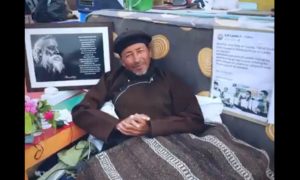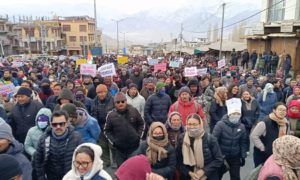There are rare instances where a major geographical feature is named after a native explorer who put it on a western map. One of those instances is the contentious Galwan river valley, where India and China are currently engaged in an escalating military conflict.
The valley is named after Ghulam Rassul Galwan who explored the course of the river. The Galwan River flows from the disputed Aksai Chin region in southern Xinjiang of China to Jammu and Kashmir.
The valley has been a point of friction between two nuclear neighbours: India and China. In 1962, the Galwan river valley was the site of military standoff between India and China.
On 4 July, a platoon of Indian Gorkha troops set up a post in the upper reaches of the valley. The post ended up cutting the lines of communication to a Chinese post in Samzungling.
The Chinese interpreted it as a premeditated attack on their post, and surrounded the Indian post, coming within 100 yards of the post. The Indian government warned China of “grave consequences” and informed them that India was determined to hold the post at all costs. The post remained surrounded for four months and was supplied by helicopters.
According to scholar Taylor Fravel, the standoff marked the “apogee of tension” for China’s leaders. The Chinese PLA bombarded it with heavy shelling and employed a battalion to attack the post.
The Indians suffered 33 killed and several wounded, and the company commander and several others were taken prisoner. If seen from the Ladakh side with powerful binoculars, the remants of the post are still visible.
This post was the first target of the Chinese and the valley continued to act as an important route for attacking Indian forces.
Who was Ghulam Rassul Galwan?
His grandfather was known as Kara Galwan, meaning a dark skinned horse thief, hence the Kashmiri proverb: gurr karun galwanas hawale meaning entrusting horse to a horse thief.
Karra was brave and is known to have sneaked into Maharajas room and put a knife on his neck, threatening that he should not be held by his soldiers.
Kara Galwan was caught in a trap set by Maharaja’s soldiers and was later executed. This is how the name “Galwan” got stuck to his family.
Gh. Rassul Galwan was born in Leh in 1878. He started his life as a porter with Sir Francis Younghusband at the age of 12. Soon he started joining the expeditions put together by Western Explorers, that knocked around Central Asia, Tibet and Ladakh of the late 19th and early 20th Centuries.
He served a host of other famous explorers and travellers like Younghusband, Longstaff, Phelps, Church, Welby and Littledale. He was among the pony men taken on by Lord Dunmore to the Pamirs in 1890. Of him the famous British explorer Dr. Tom Longstaff had written:
“Rasool Gulwan, our caravan leader was a great character. He had travelled through Tibet with Littledale, and with Robert Barrett, Phelps and Church and was rated very high by all of them. He was of the breed called Arghan, of a Yarkandi father by a Ladakhi mother. Inheriting the best characteristics of both the races, he was absolutely honest; he never took bribes nor offered them”
In 1914, he was appointed as the caravan leader (karvan bash) of the big Italian scientific expedition of Fillippo de Fillipi which explored the Rimo glacier systems.
However, he became famous as an explorer when he was part of an expedition with the British joint commissioner in 1899.
He was part of this expedition which remarked the possible routes through Chen Chenmo valley going east from Shyok river.
With this expedition he discovered an unknown river valley north to the Chen Chenmo which bears his name, “Galwan valley”.
Galwan had a lot to say and had a fervent desire to write all of it in English for the world to know. Encouraged by one of his American employers, Mrs. Katherine Barret and her husband Robert Barret, Ghulam Rassul started writing an autobiography called ‘Servant of the Sahibs- To be read aloud’.
It took him over fourteen years to finish it. Galwan had been part of their explorations in Central Asia in early nineties. Using ‘the King James Bible and a seventeenth century book of travel” as guides, Barrett taught his servant to write English and eventually to set down his story for an English-speaking public.
For more than a decade Rassul Galwan exchanged handwritten drafts of the developing manuscript with Barrett, who ‘eliminated’, ‘condensed’, ‘rewrote’, ‘punctuated’, and ‘restored’, until Rassul Galwan “at last… acquired a style with which we do not tamper”.
Galwan’s notes were sent by snail mail till 1913 and were edited by Mrs. Barret herself.
The book was published in 1924. The name, ‘To be read aloud’, came at the insistence of the editor who loved Galwan’s peculiar way of speaking English. Younghusband helped Galwan in this endeavour of his.
A funny passage from the book, in Galwan’s inimitable English:
“At the middle night all people went home and the girl did not know among us which is her husband, until they all were gone. Then she knew. The next morning many people brought money to us: some, one ruppee, some eight annas, some, four annas, some two annas. My wife was very clever, I taught her cooking business, she learned it quickly. What her mother bade her do, she did, same me (But I did not like that work very much). I found much more time to play, after my marriage”
Sir Francis Younghusband, in the introduction to Galwan’s book writes:
“He came of the very poorest. He started as a simple village lad. But in every situation he behaved like a gentleman.”
The book gives an insight into the life of the explorers back then, their habits and the difficulties they faced on the expeditions with food, travel and language of foreign lands.
The book is however often criticised as means of authenticating colonial relations. David Butz, Professor and Director of Geography and tourism studies in Brock University, in his paper one among very few researches on Galwan, “Serving sahibs with pony and pen: The discursive uses of ‘Native authenticity” states:
“The focus of the book on Rassul Galwan’s growth through colonial labor, combined with the authenticity imposed on him and his account through a number of textual and editorial devices, allows the book to be read credibly as a text that aids the colonial establishment in utilising a discourse of Native authenticity in support of a somewhat discredited discourse of benevolent colonial labor relations.”
In the introductory notes Younhusband writes “In this book we get the an answer to the puzzle”. The puzzle?: “Why Himalayan peoples should be as ready as they are to undergo hardships, to run risks of the most serious nature…[to] readily work through long and arduous days”, and why, “most wonderful of all, they are full of gratitude to their employer when they leave his service”
Hence, notes of Younghusband about Galwan are also a source of scathing anti-colonial criticism and rightly so.
In 1917, the British commissioner appointed him as the head of contracters or Aksakal of Leh, a term used for a rich and powerful contractor.
Lord Dunmore, says of Rassul Galwan and his brethren in a paper read to the Royal Geographical Society:
“A better set of men, hardier or more willing, I have never met with”
There are tales and anecdotes to hear from his descendants in Leh. They describe him as a strong, brave but a funny and a kind man, who made a name by working hard. Apart from Galwan Valley a small village in Budgam called Galwanpora also seems to be named after his clan.
Khawar Khan Achakzai is a published author, a medical Doctor by profession, and student of history.
Free Press Kashmir is now on Telegram. Click here to Join.
Like this story? Producing quality journalism costs. Make a Donation & help keep our work going.






